Peng Luo
Feature-free regression kriging
Jul 10, 2025Abstract:Spatial interpolation is a crucial task in geography. As perhaps the most widely used interpolation methods, geostatistical models -- such as Ordinary Kriging (OK) -- assume spatial stationarity, which makes it difficult to capture the nonstationary characteristics of geographic variables. A common solution is trend surface modeling (e.g., Regression Kriging, RK), which relies on external explanatory variables to model the trend and then applies geostatistical interpolation to the residuals. However, this approach requires high-quality and readily available explanatory variables, which are often lacking in many spatial interpolation scenarios -- such as estimating heavy metal concentrations underground. This study proposes a Feature-Free Regression Kriging (FFRK) method, which automatically extracts geospatial features -- including local dependence, local heterogeneity, and geosimilarity -- to construct a regression-based trend surface without requiring external explanatory variables. We conducted experiments on the spatial distribution prediction of three heavy metals in a mining area in Australia. In comparison with 17 classical interpolation methods, the results indicate that FFRK, which does not incorporate any explanatory variables and relies solely on extracted geospatial features, consistently outperforms both conventional Kriging techniques and machine learning models that depend on explanatory variables. This approach effectively addresses spatial nonstationarity while reducing the cost of acquiring explanatory variables, improving both prediction accuracy and generalization ability. This finding suggests that an accurate characterization of geospatial features based on domain knowledge can significantly enhance spatial prediction performance -- potentially yielding greater improvements than merely adopting more advanced statistical models.
Mechanistic Fine-tuning for In-context Learning
May 20, 2025Abstract:In-context Learning (ICL) utilizes structured demonstration-query inputs to induce few-shot learning on Language Models (LMs), which are not originally pre-trained on ICL-style data. To bridge the gap between ICL and pre-training, some approaches fine-tune LMs on large ICL-style datasets by an end-to-end paradigm with massive computational costs. To reduce such costs, in this paper, we propose Attention Behavior Fine-Tuning (ABFT), utilizing the previous findings on the inner mechanism of ICL, building training objectives on the attention scores instead of the final outputs, to force the attention scores to focus on the correct label tokens presented in the context and mitigate attention scores from the wrong label tokens. Our experiments on 9 modern LMs and 8 datasets empirically find that ABFT outperforms in performance, robustness, unbiasedness, and efficiency, with only around 0.01% data cost compared to the previous methods. Moreover, our subsequent analysis finds that the end-to-end training objective contains the ABFT objective, suggesting the implicit bias of ICL-style data to the emergence of induction heads. Our work demonstrates the possibility of controlling specific module sequences within LMs to improve their behavior, opening up the future application of mechanistic interpretability.
CoCo-Bench: A Comprehensive Code Benchmark For Multi-task Large Language Model Evaluation
Apr 29, 2025Abstract:Large language models (LLMs) play a crucial role in software engineering, excelling in tasks like code generation and maintenance. However, existing benchmarks are often narrow in scope, focusing on a specific task and lack a comprehensive evaluation framework that reflects real-world applications. To address these gaps, we introduce CoCo-Bench (Comprehensive Code Benchmark), designed to evaluate LLMs across four critical dimensions: code understanding, code generation, code modification, and code review. These dimensions capture essential developer needs, ensuring a more systematic and representative evaluation. CoCo-Bench includes multiple programming languages and varying task difficulties, with rigorous manual review to ensure data quality and accuracy. Empirical results show that CoCo-Bench aligns with existing benchmarks while uncovering significant variations in model performance, effectively highlighting strengths and weaknesses. By offering a holistic and objective evaluation, CoCo-Bench provides valuable insights to guide future research and technological advancements in code-oriented LLMs, establishing a reliable benchmark for the field.
Interpreting core forms of urban morphology linked to urban functions with explainable graph neural network
Feb 22, 2025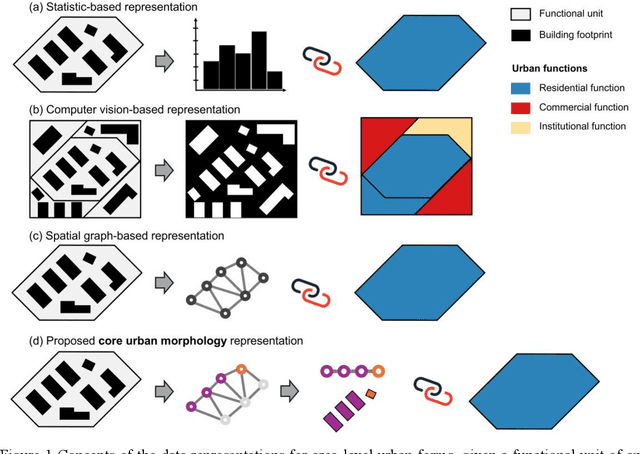
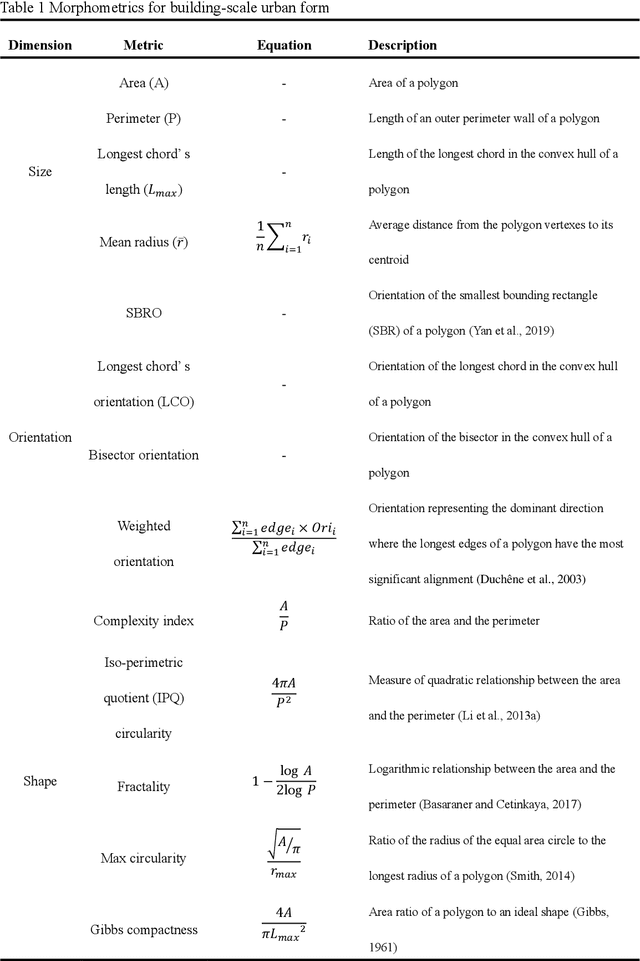
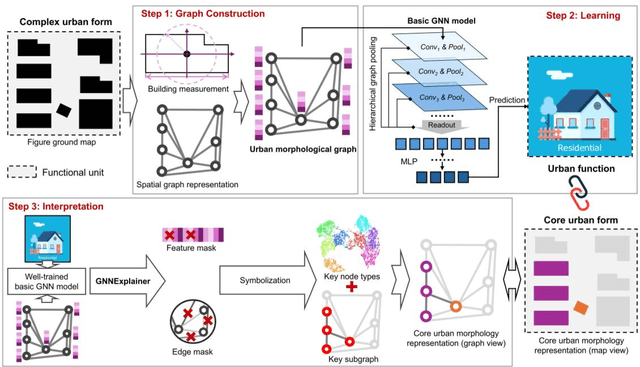
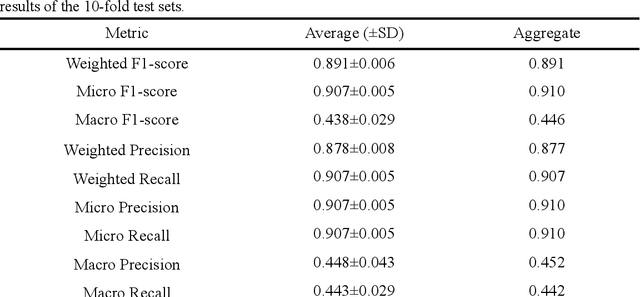
Abstract:Understanding the high-order relationship between urban form and function is essential for modeling the underlying mechanisms of sustainable urban systems. Nevertheless, it is challenging to establish an accurate data representation for complex urban forms that are readily explicable in human terms. This study proposed the concept of core urban morphology representation and developed an explainable deep learning framework for explicably symbolizing complex urban forms into the novel representation, which we call CoMo. By interpretating the well-trained deep learning model with a stable weighted F1-score of 89.14%, CoMo presents a promising approach for revealing links between urban function and urban form in terms of core urban morphology representation. Using Boston as a study area, we analyzed the core urban forms at the individual-building, block, and neighborhood level that are important to corresponding urban functions. The residential core forms follow a gradual morphological pattern along the urban spine, which is consistent with a center-urban-suburban transition. Furthermore, we prove that urban morphology directly affects land use efficiency, which has a significantly strong correlation with the location (R2=0.721, p<0.001). Overall, CoMo can explicably symbolize urban forms, provide evidence for the classic urban location theory, and offer mechanistic insights for digital twins.
GeoConformal prediction: a model-agnostic framework of measuring the uncertainty of spatial prediction
Dec 05, 2024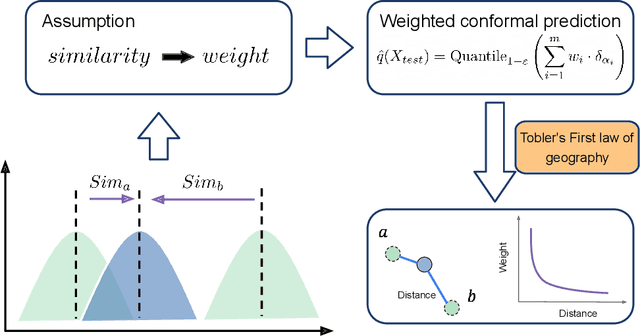
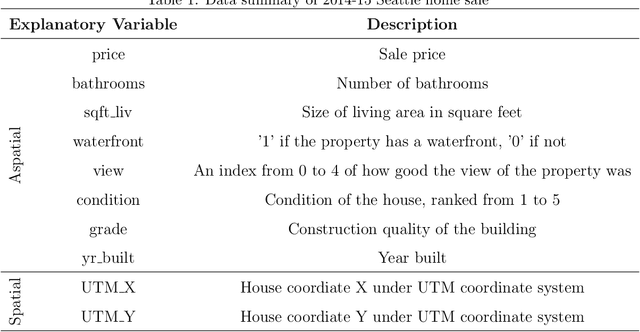
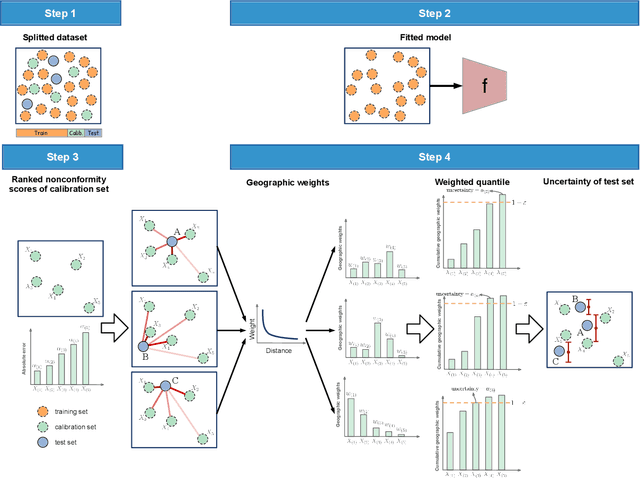
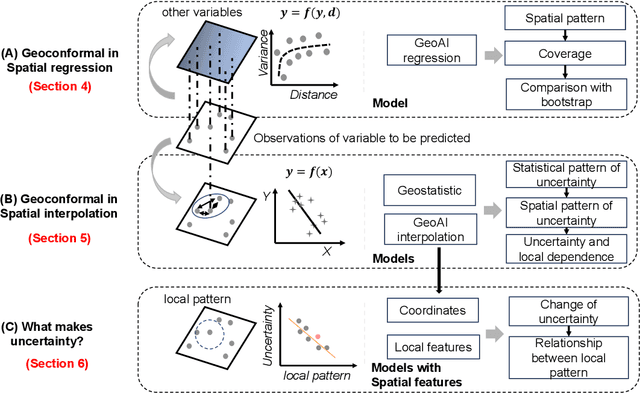
Abstract:Spatial prediction is a fundamental task in geography. In recent years, with advances in geospatial artificial intelligence (GeoAI), numerous models have been developed to improve the accuracy of geographic variable predictions. Beyond achieving higher accuracy, it is equally important to obtain predictions with uncertainty measures to enhance model credibility and support responsible spatial prediction. Although geostatistic methods like Kriging offer some level of uncertainty assessment, such as Kriging variance, these measurements are not always accurate and lack general applicability to other spatial models. To address this issue, we propose a model-agnostic uncertainty assessment method called GeoConformal Prediction, which incorporates geographical weighting into conformal prediction. We applied it to two classic spatial prediction cases, spatial regression and spatial interpolation, to evaluate its reliability. First, in the spatial regression case, we used XGBoost to predict housing prices, followed by GeoConformal to calculate uncertainty. Our results show that GeoConformal achieved a coverage rate of 93.67%, while Bootstrap methods only reached a maximum coverage of 68.33% after 2000 runs. Next, we applied GeoConformal to spatial interpolation models. We found that the uncertainty obtained from GeoConformal aligned closely with the variance in Kriging. Finally, using GeoConformal, we analyzed the sources of uncertainty in spatial prediction. We found that explicitly including local features in AI models can significantly reduce prediction uncertainty, especially in areas with strong local dependence. Our findings suggest that GeoConformal holds potential not only for geographic knowledge discovery but also for guiding the design of future GeoAI models, paving the way for more reliable and interpretable spatial prediction frameworks.
Genetic Quantization-Aware Approximation for Non-Linear Operations in Transformers
Mar 29, 2024



Abstract:Non-linear functions are prevalent in Transformers and their lightweight variants, incurring substantial and frequently underestimated hardware costs. Previous state-of-the-art works optimize these operations by piece-wise linear approximation and store the parameters in look-up tables (LUT), but most of them require unfriendly high-precision arithmetics such as FP/INT 32 and lack consideration of integer-only INT quantization. This paper proposed a genetic LUT-Approximation algorithm namely GQA-LUT that can automatically determine the parameters with quantization awareness. The results demonstrate that GQA-LUT achieves negligible degradation on the challenging semantic segmentation task for both vanilla and linear Transformer models. Besides, proposed GQA-LUT enables the employment of INT8-based LUT-Approximation that achieves an area savings of 81.3~81.7% and a power reduction of 79.3~80.2% compared to the high-precision FP/INT 32 alternatives. Code is available at https:// github.com/PingchengDong/GQA-LUT.
Uncover the nature of overlapping community in cities
Jan 31, 2024



Abstract:Urban spaces, though often perceived as discrete communities, are shared by various functional and social groups. Our study introduces a graph-based physics-aware deep learning framework, illuminating the intricate overlapping nature inherent in urban communities. Through analysis of individual mobile phone positioning data at Twin Cities metro area (TCMA) in Minnesota, USA, our findings reveal that 95.7 % of urban functional complexity stems from the overlapping structure of communities during weekdays. Significantly, our research not only quantifies these overlaps but also reveals their compelling correlations with income and racial indicators, unraveling the complex segregation patterns in U.S. cities. As the first to elucidate the overlapping nature of urban communities, this work offers a unique geospatial perspective on looking at urban structures, highlighting the nuanced interplay of socioeconomic dynamics within cities.
An unsupervised approach for semantic place annotation of trajectories based on the prior probability
Apr 20, 2022



Abstract:Semantic place annotation can provide individual semantics, which can be of great help in the field of trajectory data mining. Most existing methods rely on annotated or external data and require retraining following a change of region, thus preventing their large-scale applications. Herein, we propose an unsupervised method denoted as UPAPP for the semantic place annotation of trajectories using spatiotemporal information. The Bayesian Criterion is specifically employed to decompose the spatiotemporal probability of the candidate place into spatial probability, duration probability, and visiting time probability. Spatial information in ROI and POI data is subsequently adopted to calculate the spatial probability. In terms of the temporal probabilities, the Term Frequency Inverse Document Frequency weighting algorithm is used to count the potential visits to different place types in the trajectories, and generates the prior probabilities of the visiting time and duration. The spatiotemporal probability of the candidate place is then combined with the importance of the place category to annotate the visited places. Validation with a trajectory dataset collected by 709 volunteers in Beijing showed that our method achieved an overall and average accuracy of 0.712 and 0.720, respectively, indicating that the visited places can be annotated accurately without any external data.
Real-world Deep Local Motion Deblurring
Apr 18, 2022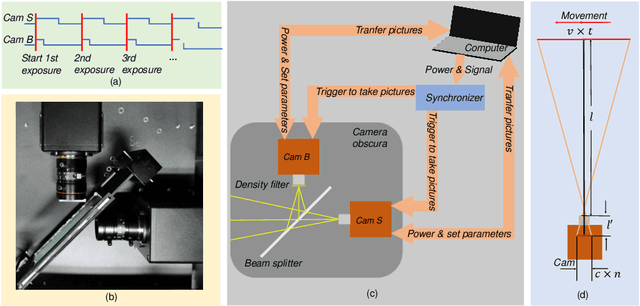


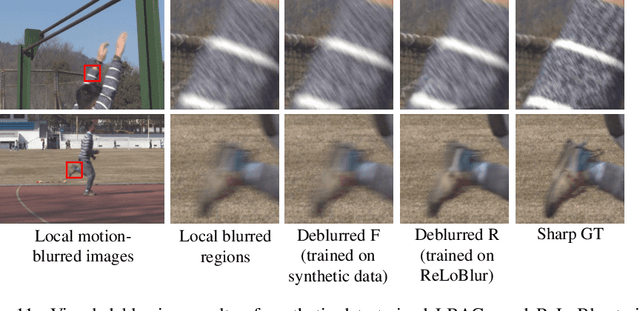
Abstract:Most existing deblurring methods focus on removing global blur caused by camera shake, while they cannot well handle local blur caused by object movements. To fill the vacancy of local deblurring in real scenes, we establish the first real local motion blur dataset (ReLoBlur), which is captured by a synchronized beam-splitting photographing system and corrected by a post-progressing pipeline. Based on ReLoBlur, we propose a Local Blur-Aware Gated network (LBAG) and several local blur-aware techniques to bridge the gap between global and local deblurring: 1) a blur detection approach based on background subtraction to localize blurred regions; 2) a gate mechanism to guide our network to focus on blurred regions; and 3) a blur-aware patch cropping strategy to address data imbalance problem. Extensive experiments prove the reliability of ReLoBlur dataset, and demonstrate that LBAG achieves better performance than state-of-the-art global deblurring methods without our proposed local blur-aware techniques.
 Add to Chrome
Add to Chrome Add to Firefox
Add to Firefox Add to Edge
Add to Edge